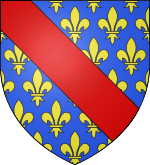Robert de Clermont
Robert von Clermont , also known as Robert de France , (* 1256 - 7 February 1317 ) was a royal prince of the French ruling dynasty of the Capetians . He was the youngest son of King Louis IX. of the saint († 1270) and Margaret of Provence († 1295). He is the progenitor of the Bourbon house , which is still in existence today , a Capetian branch line.
Life
Like all his older brothers received Robert in 1269 with the Counts of Clermont-en-Beauvaisis and the basic rule Creil-sur-Oise and Sacy-le-Grand , a relatively small prerogative , unlike his uncles, with more significant territories in France have been equipped were. Robert was a French chamberlain and shaped by the example of his famous father and the knight ideals of his time, but did not take part in the fateful seventh crusade to Tunis . In 1272 Robert took King Philip III's entourage . on the campaign against Count Roger Bernard III. from Foix . In May 1279, at a tournament in Paris in honor of Prince Karl von Salerno , he received a severe head wound that led to persistent mental confusion, as a result of which he was no longer able to play an important political role at the royal court.
Robert of Clermont is buried in Saint-Jacques in Paris.
Robert was betrothed to the Vice Countess of Limoges , Maria, in 1270 . However, in 1276 he married Beatrix , a granddaughter of Duke Hugo IV of Burgundy . Beatrix inherited the County of Charolais from his father John of Burgundy in 1276 , and the Seigneurie Bourbon from his mother Agnes de Dampierre in 1287/88 .
Ancestor of the Bourbons
The Roberts family received its name through the upgrading of the Bourbon rule to a duchy under Robert's son Ludwig the Lame of King Charles IV . All Bourbons living after him are descended from him and Beatrix von Burgund-Bourbon. As dukes of Bourbon, counts of La Marche and counts and dukes of Vendôme , they were represented as French feudal princes in the late Middle Ages. In 1525 the dynasty took the first place of the princes of royal blood and with Henry IV they came to the French royal throne in 1589, which they held with interruptions until 1848. The Spanish kingdom as well as the Italian duchy of Parma later came under Bourbon rule. The current ruling heads of state from the House of Bourbon are King Felipe VI. of Spain and Grand Duke Henri of Luxembourg .
ancestors
|
Philip II August (1165-1223) |
Isabelle of Hainaut (1170–1190) |
Alfonso VIII of Castile (1155-1214) |
Eleonore Plantagenet (1161-1214) |
Alfonso II of Provence (1180–1209) |
Garsende II of Sabran (1180–1242) |
Thomas I of Savoy (1180–1233) |
Beatrix of Geneva (? –1252) |
||||||||||||||||||||||||||||||||||||||||||||||||||||||
|
Louis VIII the Lion (1187-1226) |
Blanka of Castile (1188–1252) |
Raimund Berengar V. (1205-1245) |
Beatrix of Savoy (? –1266) |
||||||||||||||||||||||||||||||||||||||||||||||||||||||||||
|
Louis IX the saint (1214-1270) |
Margaret of Provence (1221–1295) |
||||||||||||||||||||||||||||||||||||||||||||||||||||||||||||
|
Robert of Clermont (1256-1317) |
|||||||||||||||||||||||||||||||||||||||||||||||||||||||||||||
progeny
The children of Roberts and Beatrix of Burgundy were:
- Louis I the Lame (Louis I. le Boiteux) (* 1279; † 1341), Count of Clermont-en-Beauvaisis, from 1327 Duke of Bourbon and Count of La Marche
- Blanche (* 1281; † 1304)
- ∞ married in 1303 to Robert VII († 1325), Count of Auvergne and Boulogne ( House of Auvergne )
- Johann (Jean) (* 1283; † 1316), Lord of Charolais
- Marie (* 1285; † 1372), nun in Poissy
- Peter (Pierre) (* 1287; † ap.1330), priest in Paris
- Margaret (Marguerite) (* 1289; † 1309)
- ∞ married 1308 to John I , Margrave of Namur (* 1267; † 1330)
literature
- Louis Carolus-Barré: Les grands tournois de Compiègne et de Senlis en l'honneur de Charles, Prince de Salerne (May 1279). In: Bulletin de la Société Nationale des Antiquaires de France. 1978/79, ZDB -ID 211520-7 , pp. 87-100.
Web links
- Robert of France at fmg.ac (English)
Individual evidence
- ↑ André Leguai: . Bourbon, II domination / Duchy (Territorial Development), the second territorial expansion in the High and Late Middle Ages . In: Lexicon of the Middle Ages . Volume 2. dtv, Munich 2002, ISBN 3-423-59057-2 , column 503.
| personal data | |
|---|---|
| SURNAME | Robert de Clermont |
| ALTERNATIVE NAMES | Robert of Clermont; Robert de France |
| BRIEF DESCRIPTION | royal French prince |
| DATE OF BIRTH | 1256 |
| DATE OF DEATH | February 7, 1317 |

